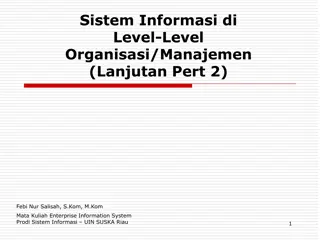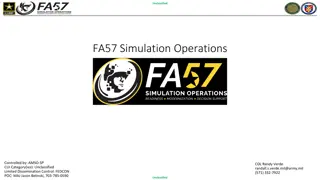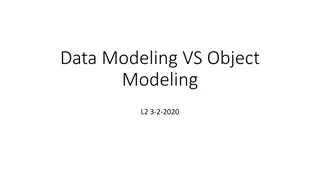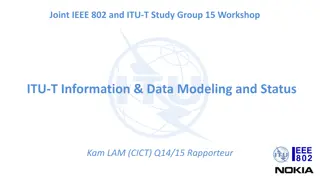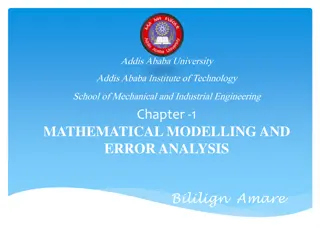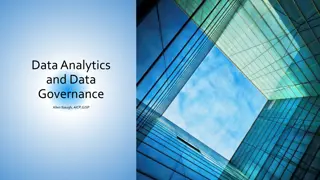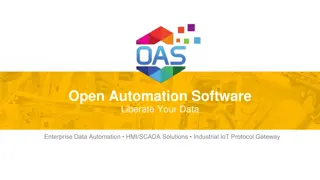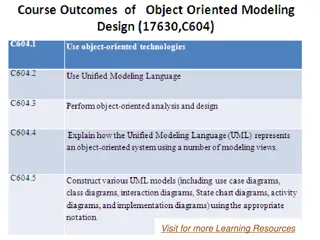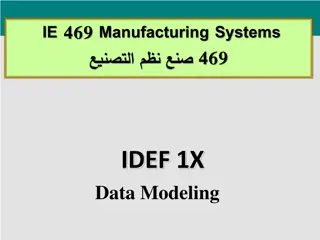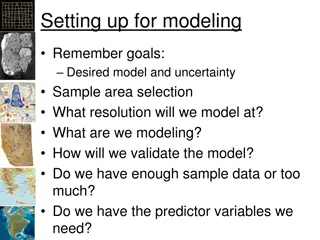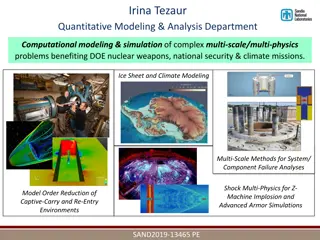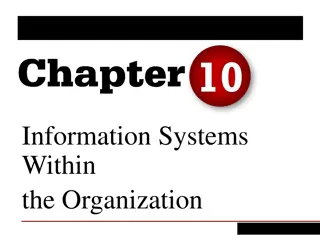Importance of Data Modeling in Industrial Information Systems
Introduction to data modeling and design in Industrial Information Systems at King Saud University College of Engineering. The chapter covers the significance of data modeling, capturing data characteristics, structural information, and the role of databases and DBMS. Data modeling fills crucial gaps in system requirements, focusing on the complexity of data in modern IS applications. It emphasizes the importance of understanding data characteristics for designing databases and programs, illustrating common features across different organizations for automatic program generation.
Download Presentation

Please find below an Image/Link to download the presentation.
The content on the website is provided AS IS for your information and personal use only. It may not be sold, licensed, or shared on other websites without obtaining consent from the author.If you encounter any issues during the download, it is possible that the publisher has removed the file from their server.
You are allowed to download the files provided on this website for personal or commercial use, subject to the condition that they are used lawfully. All files are the property of their respective owners.
The content on the website is provided AS IS for your information and personal use only. It may not be sold, licensed, or shared on other websites without obtaining consent from the author.
E N D
Presentation Transcript
King Saud University College of Engineering IE 462: Industrial Information Systems Fall 2018 (1st Sem. 1439-40H) Chapter 3 Data Modeling and Design p1 Introduction Prepared by: Ahmed M. El-Sherbeeny, PhD 1
Lesson Overview Introduction (p1) E-R Diagram (p2) Case Studies (p3) 2
Lesson Overview Introduction (p1) o Introduction o Databases and DBMS DBMS Classes Database Structures DBMS Architecture o Conceptual Data Modeling Process o Gathering Information for Conceptual Data Modeling 3
Introduction C:\Users\User\AppData\Local\Microsoft\Windows\Temporary Internet Files\Content.IE5\TYSL3NYF\MC900442150[1].png 4
Introduction Remember DFD: o Technique shows how, where, and when data are used or changed in an information system o But does not show definition, structure, and relationships within the data Data modeling o Fills this crucial gap in the system o System developers believe this to be most important part of the statement of IS requirements IE462 5
Introduction Importance of Data Modeling: Necessary to capture characteristics of data in the design of databases, programs o e.g. customer name is limited to a specified set of values o e.g. product can be in only 1 product line at a time Data, not processes, are the most complex aspects of many modern IS o e.g. validating data in transaction processing, sales tracking IE462 6
Introduction Importance of Data Modeling (cont.): Characteristics about data should have common features for the same applications in different organizations Structural information about data is essential for automatic program generation o e.g. automatic design of a computer screen for entry of customer order IE462 7
Databases and DBMS C:\Users\User\AppData\Local\Microsoft\Windows\Temporary Internet Files\Content.IE5\TYSL3NYF\MC900442150[1].png 8
Databases A database is a computerized filing cabinet that stores data (i.e. collection of records) defined and filed by users within the organization The database system has both hardware and software components Hardware is the physical storage medium for the data (hard disk, CD, tape, etc.) Software is the medium through which the user accesses the physically stored data o This software is called the DataBase Management System (DBMS) IE462 9
Database and Information Systems Databases are an essential component of any information system IE462 10
DBMS Database Management Systems (DBMS): o Create, control, manage, and provide use of the database (i.e. managing the database records) o Allows the user to store, retrieve, and update data Application software End-user DBMS Actual DB Data seen in actual organization Data seen in terms of DB model User interface IE462 11
Database Classification We discuss several ways to classify/view databases: o Classes of database systems o Database structures o Database architecture IE462 12
DBMS Classes C:\Users\User\AppData\Local\Microsoft\Windows\Temporary Internet Files\Content.IE5\TYSL3NYF\MC900442150[1].png 13
DBMS Classes There are three classes of database systems with different levels of complexity: o Enterprise databases o Workstation databases o Personal databases IE462 14
DBMS Classes (cont.) 1. Enterprise Database A large database that runs on one or more servers and may have several remote client users It must be capable of handling a large quantity of transactions and the execution must be in real-time o e.g. a transaction involving an ATM debit recorded in seconds DBMS like Oracle (Oracle Corporation) and DB2 (IBM) are typically used for these applications IE462 15
DBMS Classes (cont.) 2. Workstation/Workgroup Database Runs on one server and distributes information to several client machines running on the same local area network (LAN) DBMS must be capable of: o handling multiple clients who are independently generating transactions, thus: o changing the contents of one or more databases running concurrently on the DBMS Microsoft s SQL Server, which supports client-server architecture, is a popular choice for workgroup applications IE462 16
DBMS Classes (cont.) 3. Personal Database A personal database runs on a single personal computer (PC) Access DBMS is a good example of a personal database IE462 17
Database Structures C:\Users\User\AppData\Local\Microsoft\Windows\Temporary Internet Files\Content.IE5\TYSL3NYF\MC900442150[1].png 18
Database Structures There are 4 types of database system structures: o Hierarchical o Network o Object-oriented o Relational IE462 19
Database Structures (cont.) 1. Hierarchical Database Records contain information about parent/child relationships, just like a tree structure Data can be accessed and updated rapidly Each child in the tree may have only one parent, and relationships/linkages between children are not permitted IE462 20
Database Structures (cont.) 2. Network Database Network databases are mainly used on large digital computers Also has a hierarchical structure (cobweb or interconnected network of records) Each child can have more than one parent (i.e. suitable for many-to-many relationships in data) IE462 21
Database Structures (cont.) 3. Object-Oriented Database Information is represented in the form of objects (which are themselves stored in the OO database) Each object consists of two elements: o Data (e.g., sound, video, text, or graphics) o Instructions for what to do with the data More expensive to develop, but provide powerful multimedia capability IE462 22
Database Structures (cont.) 4. Relational Database Data is stored in tables, each having a key field that identifies each row This model is more reliable than either the hierarchical or network database structures It can be used with little or no training It is the foundation of modern DBMS; we will discuss this model in detail in this chapter IE462 23
DBMS Architecture C:\Users\User\AppData\Local\Microsoft\Windows\Temporary Internet Files\Content.IE5\TYSL3NYF\MC900442150[1].png 24
DBMS Architecture Data representation should be done independent of how data are stored & manipulated in the computer General architecture for data representation: o Developed in 1975 by ANSI/SPARC (Standards Planning and Requirements Committee of the American National Standards Institute) o 3-level architecture based on 3 views of the data in the database: 1. External level 2. Conceptual level 3. Internal level IE462 25
DBMS Architecture IE462 26
DBMS Architecture 1. External Level External level addresses the way in which different users view the database Includes entities & attributes that the user sees and interacts with Implementation at the external level involves user interfaces ( forms , reports , summary statistics, etc.) used to interact with the database Application software End-user DBMS Actual DB Data seen in actual organization Data seen in terms of DB model User interface IE462 27
DBMS Architecture 3. Internal Level Internal level addresses data structures and the file organization used to store data within the computer Properties of internal level: o defines how data are stored* o i.e. includes data compression, data encryption, use of indexes, and other details o dependent on operating system and physical components of computer system on which the database resides IE462 28
DBMS Architecture 2. Conceptual Level Conceptual level is a holistic (i.e. complete system / big picture ) view of the database Properties of conceptual level: o defines entities, their attributes, and their relationships (to be discussed in E-R diagram lesson in detail) o describes what data are stored in the database but not how they are stored o i.e. it s a logical description of the database without saying anything about its implementation o independent of specific hardware/software platform IE462 29
DBMS Architecture 2. Conceptual Level (cont.) We focus on this conceptual/logical design of the database, aka design of a data model Design of a data model provides representation of: o entities in the enterprise o attributes of those entities, and o relationships that exist among entities IE462 30
DBMS Architecture 2. Conceptual Level (cont.) Conceptual data model: o a detailed data model o captures overall structure of organizational data o shows rules about the meaning and interrelationships among data o independent of any DBMS, implementation considerations, how data is stored in memory o usually, a subset of the project development team concentrates on data modeling while other team members focus attention on process modeling IE462 31
DBMS Architecture 2. Conceptual Level (cont.) Conceptual data model (cont.): o work of all team members is coordinated and shared through the project repository o repository is maintained by a common CASE or data modeling software tool o process and data model descriptions of system must be consistent/complete since they describe different, but complementary, views of the same IS o e.g. names of data stores on primitive level DFDs should correspond to names of data entities in E-R diagrams IE462 32
DBMS Architecture 2. Conceptual Level (cont.) Conceptual data modeling techniques (originated by Peter Chen in the late 1970s) include: o Entity-relationship (E-R) modeling; most commonly used technique/format o Class diagramming; similar format to E-R modeling, used with object-oriented analysis & design methods o Integrated Computer-Aided Manufacturing Definition 1, extended (IDEF1X); specifically designed for manufacturing applications IE462 33
Conceptual Data Modeling Process C:\Users\User\AppData\Local\Microsoft\Windows\Temporary Internet Files\Content.IE5\TYSL3NYF\MC900442150[1].png 34
Conceptual Data Modeling Process Conceptual Data Modeling Steps Process begins with developing a conceptual data model for system being replaced (if system already exists) Then new conceptual data model is built including all of the data requirements for the new system Modeling is iterative process with many checkpoints; uses rapid development methodologies Conceptual modeling methods are suitable for the planning and analysis phases of the development life cycle (SDLC) (see next slide) IE462 35
Conceptual Data Modeling Process IE462 36
Conceptual Data Modeling Process Deliverables and Outcomes Deliverable 1: Primary deliverable from conceptual data modeling step (analysis phase) is an E-R diagram E-R diagram shows(next slide): o major categories of data (rectangles on diagram) o business relationships between them (lines connecting rectangles) IE462 37
Conceptual Data Modeling Process IE462 38
Conceptual Data Modeling Process Deliverables and Outcomes (cont.) Deliverable 1 (cont.): Example from diagram: o a SUPPLIERsometimes Supplies ITEMs to company (company wants to keep track of some suppliers without designating what they can supply) o ITEM is always Supplied by one to four SUPPLIERS Diagram includes on each line, o two names (so that a relationship can be read in either direction) test it! o note, some standards include only 1 name/line IE462 39
Conceptual Data Modeling Process Deliverables and Outcomes (cont.) Deliverable 2: Deliverable 2: entries about data objects that will be stored in projectrepository, or data modeling software Repository is mechanism that links data and process models of an IS (e.g. links between data model & DFD): o Data elements included in data flows also appear in the data model, and vice versa; note, data flows are captured by manual or automated data stores o Each data store in a process model must relate to business objects (aka data entities); e.g. Inventory File data (Hoosier Burger) must correspond to 1 data objects on a data model 40
Conceptual Data Modeling Process IE462 41
Gathering Information for Conceptual Data Modeling C:\Users\User\AppData\Local\Microsoft\Windows\Temporary Internet Files\Content.IE5\TYSL3NYF\MC900442150[1].png 42
Gathering Info. for Conceptual Data Modeling During Joint Application Design (JAD) sessions/ interviews you must ask specific Q s in order to gain the perspective on data you need for the data model These Q s relate to: o explaining what the organization does o rules of how work is performed in the organization o not how or when data are processed or used to do data modeling Ways to gather this information: 1. Top-down approach 2. Bottom-up approach IE462 43
Gathering Info. for Conceptual Data Modeling 1. Top-Down Approach Top-down approach: o derives business rules for a data model from proper understanding of nature of business o usually used with a purchased data model Table 8-1: o key Q s to ask system users & business managers o help to develop accurate & complete data model, for a particular situation o ask these Q s when you begin data modeling project with a purchased data model o note, don t use technical terms (in bold); instead, frame your Q s in business terms for manager 44
Gathering Info. for Conceptual Data Modeling 2. Bottom-Up Approach You can also gather needed info. for data modeling by reviewing specific business documents used in IS: o computer displays o reports and business forms This is usually represented as: o data flows on DFDs, and this shows: o data processed by the system i.e. data that must be maintained in system s database IE462 47
Gathering Info. for Conceptual Data Modeling 2. Bottom-Up Approach (cont.) Example: customer order form used at Pine Valley Furniture (PVF) o following data must be kept in the database: o We also see important info. needed for data model: each order is from one customer, order can have multiple line items, 1 per product IE462 48
Videos to Watch Entity Relationship Diagram (ERD) Tutorial - Part 1 https://youtu.be/QpdhBUYk7Kk Entity Relationship Diagram (ERD) Tutorial - Part 2 https://youtu.be/-CuY5ADwn24 Entity-Relationship Diagrams (another system) https://youtu.be/c0_9Y8QAstg Entity Relationship Diagram (ERD) Training Video https://youtu.be/-fQ-bRllhXc IE462 50


